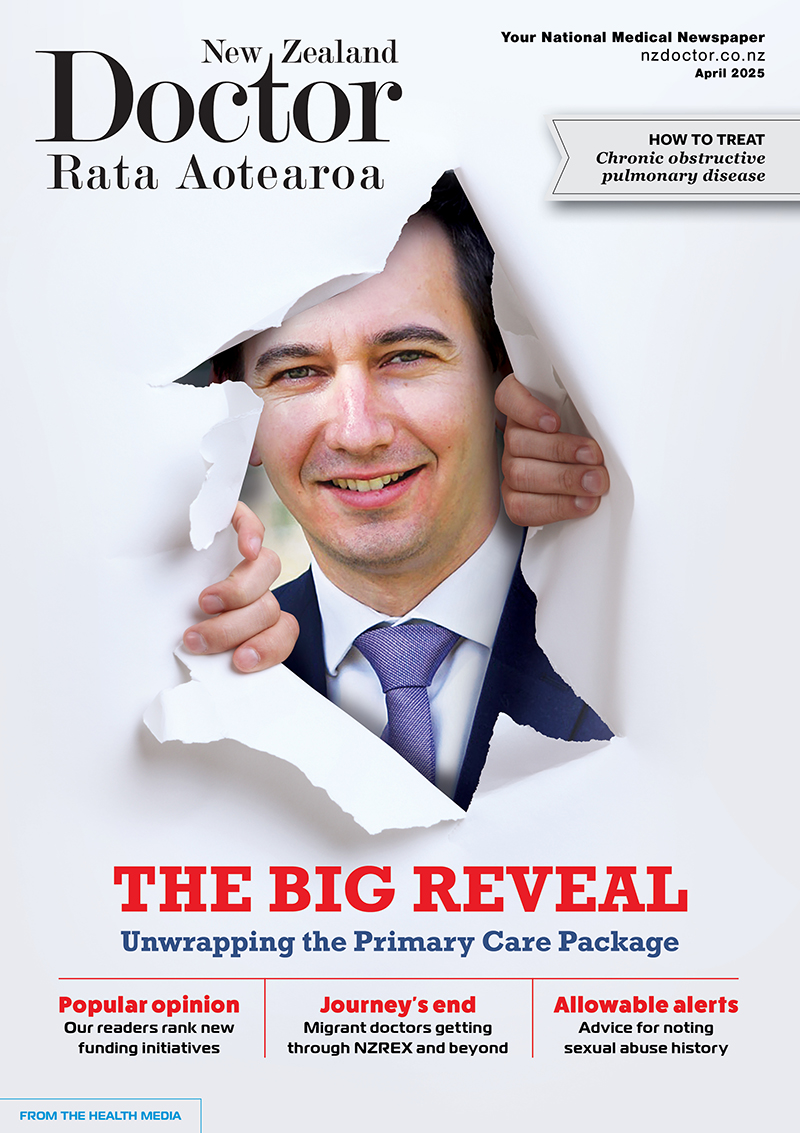Respiratory physician Lutz Beckert considers chronic obstructive pulmonary disease management, including the prevention of COPD, the importance of smoking cessation and pulmonary rehabilitation, and the lifesaving potential of addressing treatable traits. He also discusses the logic of inhaler therapy, moving from single therapy to dual and triple therapy when indicated, as well as other aspects of management
Norwegian healthcare model may be key to improving NZ’s ovarian cancer survival rates
Norwegian healthcare model may be key to improving NZ’s ovarian cancer survival rates

Healthcare models in other high-income countries such as Norway may be key to improving NZ’s ovarian cancer survival rates and require more investigation, according to the head of gynaecological cancer foundation Talk Peach.
The call to learn from the success of other international healthcare models comes as Te Whatu Ora - Health New Zealand and Te Aho o Te Kahu - the Cancer Control Agency, prepare to establish the new Cancer National Clinical Network - designed to improve health outcomes and reduce variations in access to cancer care in NZ.[1]
The new network, which is set to have its first meeting early this year, aims to tackle critical challenges in cancer care, including expanding workforce capacity to meet rising demand, creating sustainable and equitable care models and addressing disparities in access and outcomes.[2][3]
Maori, Pacific peoples, disabled individuals, and those living in poverty are disproportionately affected, facing higher rates of cancer diagnoses and poorer outcomes. The initiative will focus on reducing variations in care to ensure more coordinated and effective cancer treatment across the health system.[4]
Tash Crosby, cancer survivor and founder of Talk Peach Gynaecological Cancer Foundation says the success of oncology treatment models in parts of Scandinavia and Australia could provide insights that New Zealand can emulate as it looks to improve survival rates associated with the disease and launches the new national network.[5]
In 2014 Norway’s ovarian cancer survival rate was the highest of six countries in the International Cancer Benchmarking Partnership (ICBP), which includes Australia, Canada, Denmark, Ireland, New Zealand, Norway and the UK, a collaboration of clinicians, policymakers, researchers and data experts, seeking to explain survival differences between high-income countries with comprehensive cancer registries, similar health system expenditure, and universal health care.[6][7]
Data shows Norway, which is similar in population size to NZ, increased its five-year survival rates for ovarian cancer from 34.1% to 46.1% in the almost two decades from 1995. In contrast, New Zealand’s five-year survival rates remained relatively static - moving from 34.6% to 36.3% over the same period.[8], [9],[10]
Figures from the Cancer Registry of Norway published in 2023 show their ovarian cancer survival rates have since increased to 50.3%.[11]
Crosby says while the available data does not take into account any improvements made to New Zealand’s healthcare model following its publication, the current redesign of our national approach to cancer care by government health agencies is an opportunity to adopt current global best practices in this space.
She says early diagnosis is key to improving outcomes and is calling for the development of more culturally relevant and targeted resources to support disease awareness levels of Maori wahine and Pacific women who are generally at higher risk of ovarian cancer, compared to those of the European/other ethnic groups.* [12]
According to data from Te Aho o Te Kahu, ovarian cancer is the sixth most common cause of cancer death for New Zealand women. Every 32 hours approximately one Kiwi woman is diagnosed with ovarian cancer and around every 60 hours one dies from the disease during this time.[13],[14], [15]
Data from the WHO shows the incidence of the disease in New Zealand is projected to grow 19% by 2035.[16]
Researchers found Scandinavian countries such as Denmark and Norway, which have higher survival rates for ovarian cancer, utilise national databases to track treatment patterns and inform quality improvement initiatives. This approach allows for the identification of treatment variations, leading to better patient outcomes. In contrast, New Zealand currently lacks a comprehensive national auditing system for ovarian cancer treatment, however, Te Aho o Te Kahu is building the technology to securely share the relevant data from hospital information systems to a new national chemotherapy database.[17][18]
Until 2019, New Zealand was the only ICBP country without access to a class of medicines known as PARP inhibitors that help prevent cancer cells from repairing their DNA, causing the cells to die.[19][20][21]
Following the funding of the country’s first PARP inhibitor in 2020, another PARP inhibitor known as Zejula (niraparib) was funded in 2024 with over 100 people living with advanced ovarian cancer estimated to benefit from the maintenance treatment, regardless of whether or not they have a BRCA mutation. New Zealand now has two Government funded PARP inhibitors - which is now more closely aligned with other countries in the benchmarking partnership.[22][23][24],[25],[26]
Crosby says while variations in our healthcare systems may mean New Zealand faces more inherent barriers when compared to countries like Norway, it is crucial that we work towards continuing to improve outcomes for Kiwi women with ovarian cancer.
“Building trust is crucial when working with Maori and Pacific communities, who are disproportionately affected by ovarian cancer. However more needs to be done to focus on fostering partnerships with Maori and Pacific organisations, building those relationships, and ensuring that life-saving information is delivered in a way that resonates with their cultural values and needs.[27]
“In many cases, ovarian cancer can be asymptomatic until it advances to the later stages. Some ovarian cancer subtypes may be faster growing, causing symptoms such as significant bloating or abdominal pain to present earlier, however, every individual case is different, a large proportion of women are diagnosed when ovarian cancer is advanced,” she says.[28][29]
Crosby says symptoms of the disease may include persistent bloating, feeling full quicker, discomfort, pressure, or pain in the abdomen or pelvic area, change in bowel habits, fatigue, back pain, needing to urinate often or urgently, abnormal vaginal bleeding, indigestion, nausea, or unexplained weight changes.[30][31][32]
She says community and charitable organisations need to work together to help decrease the stigma surrounding the issue of gynaecological health and ovarian cancer.
“I’d like to see organisations having ovarian cancer information at their workplaces, on notice boards, in bathrooms, wherever women can see it and familiarise themselves with the symptoms.
“This kind of community awareness where women see it at multiple touch points could have a trickle-down effect where they receive the information and pass it on to friends and whanau also.
“In Australia, which had the second highest five-year survival rates of ICBP countries, we’ve also seen large corporates and fashion brands being involved in ovarian cancer awareness, these brands often have large social media followings and it would be great to see some New Zealand companies jump on board and make a similar commitment,” she says.[33]
Brett Marett, GSK medical director, says with the burden of ovarian cancer expected to increase within New Zealand and globally, the development of treatment options and raised awareness of the disease is critical.[34],[35]
He says PARP inhibitors are a targeted maintenance therapy that may increase the length of time before cancer progresses.[36],[37],[38], [39][40]
“The access to funded PARP inhibitor treatment options for ovarian cancer may offer hope for the many Kiwi women and their whanau that are impacted by this disease each year,” he says.[41][42]
[1] Cancer National Clinical Network - Health New Zealand | Te whatu ora. (n.d.). https://www.tewhatuora.govt.nz/corporate-information/our-health-system/strategic-initiatives-in-health-research-and-innovation/national-clinical-networks/cancer-national-clinical-network. Accessed 1 Dec 2024.
[2] Cancer National Clinical Network - Health New Zealand | Te whatu ora. (n.d.). https://www.tewhatuora.govt.nz/corporate-information/our-health-system/strategic-initiatives-in-health-research-and-innovation/national-clinical-networks/cancer-national-clinical-network. Accessed 1 Dec 2024.
[3] Apply to be a member of the Cancer National Clinical Network | Pinnacle Practices. (n.d.). https://www.pinnaclepractices.co.nz/pin-points/apply-to-be-a-member-of-the-cancer-national-clinical-network/. Accessed 1 Dec 2024.
[4] Cancer National Clinical Network - Health New Zealand | Te whatu ora. (n.d.). https://www.tewhatuora.govt.nz/corporate-information/our-health-system/strategic-initiatives-in-health-research-and-innovation/national-clinical-networks/cancer-national-clinical-network. Accessed 1 Dec 2024.
[5] SURVMARK-2 - viz1. (n.d.). https://gco.iarc.fr/survival/survmark/visualizations/viz1/?groupby=%22country%22&period=%225%22&cancer_site=%22Ovary%22&country=%22Australia%22&year=%222014%22&gender=%22Females%22&sorting=%220%22&countries=%5B%22Australia%22%2C%22Canada%22%2C%22Denmark%22%2C%22Ireland%22%2C%22New+Zealand%22%2C%22Norway%22%2C%22United+Kingdom%22%5D. Accessed 1 Dec 2024.
[6] SURVMARK-2 - viz1. (n.d.). https://gco.iarc.fr/survival/survmark/visualizations/viz1/?groupby=%22country%22&period=%225%22&cancer_site=%22Ovary%22&country=%22Australia%22&year=%222014%22&gender=%22Females%22&sorting=%220%22&countries=%5B%22Australia%22%2C%22Canada%22%2C%22Denmark%22%2C%22Ireland%22%2C%22New+Zealand%22%2C%22Norway%22%2C%22United+Kingdom%22%5D. Accessed 1 Dec 2024. Five year net survival data in 2014 only available for Australia, Canada, Denmark, New Zealand, Norway, and the UK. Ireland was part of the ICBP but data was not available for this year.
[7] McPhail, S., Barclay, M. E., Johnson, S. A., Swann, R., Alvi, R., Barisic, A., Bucher, O., Creighton, N., Denny, C. A., Dewar, R. A., Donnelly, D. W., Dowden, J. J., Downie, L., Finn, N., Gavin, A. T., Habbous, S., Huws, D. W., May, L., McClure, C. A., . . . Zalcberg, J. R. (2024). Use of chemotherapy in patients with oesophageal, stomach, colon, rectal, liver, pancreatic, lung, and ovarian cancer: an International Cancer Benchmarking Partnership (ICBP) population-based study. The Lancet Oncology, 25(3), 338–351. https://doi.org/10.1016/s1470-2045(24)00031-7 Accessed 1 Dec 2024.
[8] Country comparison: Norway / New Zealand. (n.d.). Worlddata.info. https://www.worlddata.info/country-comparison.php?country1=NOR&country2=NZL. Accessed 1 Dec 2024.
[9] SURVMARK-2 - viz1. (n.d.). https://gco.iarc.fr/survival/survmark/visualizations/viz1/?groupby=%22country%22&period=%225%22&cancer_site=%22Ovary%22&country=%22Australia%22&year=%221995%22&gender=%22Females%22&sorting=%220%22&countries=%5B%22Australia%22%2C%22Canada%22%2C%22Denmark%22%2C%22Ireland%22%2C%22New+Zealand%22%2C%22Norway%22%2C%22United+Kingdom%22%5D. Accessed 1 Dec 2024.
[10] SURVMARK-2 - viz1. (n.d.). https://gco.iarc.fr/survival/survmark/visualizations/viz1/?groupby=%22country%22&period=%225%22&cancer_site=%22Ovary%22&country=%22Australia%22&year=%222014%22&gender=%22Females%22&sorting=%220%22&countries=%5B%22Australia%22%2C%22Canada%22%2C%22Denmark%22%2C%22Ireland%22%2C%22New+Zealand%22%2C%22Norway%22%2C%22United+Kingdom%22%5D. Accessed 1 Dec 2024.
[11] Giske Ursin;National quality registry for gynecological cancer;2023;1-112.
[12] Ovarian cancer – early detection and referral - bpacnz. (n.d.). https://bpac.org.nz/2023/ovarian-cancer.aspx Accessed 1 Dec 2024.
*In 2019, the age-standardised incidence rate for Pacific peoples was 19.5 per 100,000 females which was 2.0 times greater than the rate in Maori (9.6 per 100,000 females) and 2.2 times greater than in European/Other ethnic groups (8.9 per 100,000 females). Data not based on studies powered for statistical comparison across ethnicities.
[13] Te Aho o Te Kahu - Cancer Control Agency. (n.d.). Te Aho O Te Kahu - Cancer Control Agency. https://teaho.govt.nz/cancer-numbers/cancer-deaths. (Screenshot here). Accessed 1 Dec 2024.
[14] Te Whata Ora. Cancer web tool. (n.d.-b). https://tewhatuora.shinyapps.io/cancer-web-tool/ Rate of All Ovarian (C56) Cancer Registrations in 2018-2022 by Prioritised Ethnicity. Accessed 13 Dec 2024.
[15] Te Whata Ora. Cancer web tool. (n.d.-b). Deaths. https://tewhatuora.shinyapps.io/cancer-web-tool/ Rate of All Ovarian (C56) Cancer Deaths in 2018-2022 by Prioritised Ethnicity. Accessed 13 Dec 2024.
[16] WHO - Cancer tomorrow. (n.d.). https://gco.iarc.fr/tomorrow/en/dataviz/trends?types=0_1&sexes=2&mode=population&group_populations=1&multiple_populations=1&multiple_cancers=0&cancers=25&populations=554 (Calculations = NZ incidence from 410 to 486 = 19% increase from 2025 to 2035). Accessed 19 Dec 2024.
[17] Norell, C. H., Butler, J., Farrell, R., Altman, A., Bentley, J., Cabasag, C. J., Cohen, P. A., Fegan, S., Fung-Kee-Fung, M., Gourley, C., Hacker, N. F., Hanna, L., Høgdall, C. K., Kristensen, G., Kwon, J., McNally, O., Nelson, G., Nordin, A., O’Donnell, D., . . . Harrison, S. (2020). Exploring international differences in ovarian cancer treatment: a comparison of clinical practice guidelines and patterns of care. International Journal of Gynecological Cancer, 30(11), 1748–1756. https://doi.org/10.1136/ijgc-2020-001403 Accessed 1 Dec 2024.
[18] Te Aho o Te Kahu - Cancer Control Agency. (n.d.). Te Aho O Te Kahu - Cancer Control Agency. https://teaho.govt.nz/reports/canshare/act-now-programme. Accessed 20 Dec 2024.
[19] Norell, C. H., Butler, J., Farrell, R., Altman, A., Bentley, J., Cabasag, C. J., Cohen, P. A., Fegan, S., Fung-Kee-Fung, M., Gourley, C., Hacker, N. F., Hanna, L., Høgdall, C. K., Kristensen, G., Kwon, J., McNally, O., Nelson, G., Nordin, A., O’Donnell, D., . . . Harrison, S. (2020). Exploring international differences in ovarian cancer treatment: a comparison of clinical practice guidelines and patterns of care. International Journal of Gynecological Cancer, 30(11), 1748–1756. https://doi.org/10.1136/ijgc-2020-001403. Accessed 20 Dec 2024
[20] Definition of PARP inhibitor - NCI Dictionary of Cancer Terms. (n.d.). Cancer.gov. Accessed 1 Dec 2024. https://www.cancer.gov/publications/dictionaries/cancer-terms/def/parp-inhibitor. Accessed 20 Dec 2024
[21] PARP inhibitors as initial treatment for ovarian cancer. (2019, October 29). National Cancer Institute. https://www.cancer.gov/news-events/cancer-currents-blog/2019/parp-inhibitors-ovarian-cancer-initial-treatment#:~:text=PARP%20Inhibitors%20Show%20Promise%20as%20Initial%20Treatment%20for%20Ovarian%20Cancer,-Subscribe&text=PARP%20inhibitors%20block%20the%20repair%20of%20broken%20DNA. Accessed 1 Dec 2024.
[22] PHARMAC;2019;1-7;Proposal to fund two new cancer treatments: olaparib and fulvestrant
[23] Medsafe.govt.nz Zejula (niraparib) https://www.medsafe.govt.nz/profs/datasheet/z/zejulacap.pdf (Accessed 28 Jan 2025)
[24] González Martín A, et al. N Engl J Med 2019;381:2391–402. Accessible here. (Accessed 1 Dec 2024)
[25] Pharmac;2024;1-2;Summary of decision: niraparib for ovarian cancer; available at https://pharmac.govt.nz/news-and-resources/news/summary-of-decision-niraparib-for-ovarian-cancer (Accessed 1 Dec 2024)
[26] Norell CH;Int J Gynecol Cancer;2020;30;1748–1756
[27] Ovarian cancer – early detection and referral - bpacnz. (n.d.). https://bpac.org.nz/2023/ovarian-cancer.aspx Accessed 1 Dec 2024.
[28] Ovarian cancer – early detection and referral - bpacnz. (n.d.). https://bpac.org.nz/2023/ovarian-cancer.aspx Accessed 1 Dec 2024.
[29] Doubeni, C. A., Doubeni, A. R. B., & Myers, A. E. (2016, June 1). Diagnosis and management of ovarian cancer. AAFP. https://www.aafp.org/pubs/afp/issues/2016/0601/p937.html. Accessed 1 Dec 2024.
[30] Doubeni, C. A., Doubeni, A. R. B., & Myers, A. E. (2016, June 1). Diagnosis and management of ovarian cancer. AAFP. https://www.aafp.org/pubs/afp/issues/2016/0601/p937.html. Accessed 1 Dec 2024.
[31] Ovarian cancer - Cancer Society NZ. (2021, January 12). Cancer Society NZ. https://www.cancer.org.nz/cancer/types-of-cancer/ovarian-cancer/#:~:text=Signs%20and%20symptoms%20of%20ovarian%20cancer%20may%20include%3A,vaginal%20bleeding%208%20weight%20changes%20for%20no%20reason. Accessed 1 Dec 2024.
[32] Signs and symptoms of ovarian cancer & cysts, masses, tumors. (n.d.). City of Hope. https://www.cancercenter.com/cancer-types/ovarian-cancer/symptoms . Accessed 29 Jan 2025.
[33] SURVMARK-2 - viz1. (n.d.). https://gco.iarc.fr/survival/survmark/visualizations/viz1/?groupby=%22country%22&period=%225%22&cancer_site=%22Ovary%22&country=%22Australia%22&year=%222014%22&gender=%22Females%22&sorting=%220%22&countries=%5B%22Australia%22%2C%22Canada%22%2C%22Denmark%22%2C%22Ireland%22%2C%22New+Zealand%22%2C%22Norway%22%2C%22United+Kingdom%22%5D. Accessed 1 Dec 2024. Five year net survival data in 2014 only available for Australia, Canada, Denmark, New Zealand, Norway, and the UK
[34] WHO - Cancer tomorrow. (n.d.). https://gco.iarc.fr/tomorrow/en/dataviz/trends?types=0_1&sexes=2&mode=population&group_populations=1&multiple_populations=1&multiple_cancers=0&cancers=25&populations=554. Accessed 1 Dec 2024.
[35] Everhobbes. (n.d.). Ovarian Cancer key Stats*. World Ovarian Cancer Coalition. https://worldovariancancercoalition.org/about-ovarian-cancer/key-stats/#:~:text=According%20to%20Globocan's%202022%20projections,of%20almost%2070%25%20from%202022. Accessed 1 Dec 2024.
[36] Hunia J, Gawalski K, Szredzka A, Suskiewicz MJ, Nowis D. The potential of PARP inhibitors in targeted cancer therapy and immunotherapy. Front Mol Biosci. 2022 Dec 1;9:1073797. doi: 10.3389/fmolb.2022.1073797. PMID: 36533080; PMCID: PMC9751342.
[37] PARP inhibitors as initial treatment for ovarian cancer. (2019, October 29). National Cancer Institute. https://www.cancer.gov/news-events/cancer-currents-blog/2019/parp-inhibitors-ovarian-cancer-initial-treatment#:~:text=PARP%20Inhibitors%20Show%20Promise%20as%20Initial%20Treatment%20for%20Ovarian%20Cancer,-Subscribe&text=PARP%20inhibitors%20block%20the%20repair%20of%20broken%20DNA. Accessed 1 Dec 2024.
[38] González Martín A, et al. N Engl J Med 2019;381:2391–402. Accessible here. (Accessed 1 Dec 2024)
[39] Li, N., Zhu, J., Yin, R., Wang, J., Pan, L., Kong, B., Zheng, H., Liu, J., Wu, X., Wang, L., Huang, Y., Wang, K., Zou, D., Zhao, H., Wang, C., Li, W., An, L., Lou, G., Li, G., Wu, L. (2022). Efficacy and safety of niraparib as maintenance treatment in patients with newly diagnosed advanced ovarian cancer using an individualized starting dose (PRIME Study): A randomized, double-blind, placebo-controlled, phase 3 trial (LBA 5). Gynaecologic Oncology, 166, S50–S51. https://doi.org/10.1016/s0090-8258(22)01298-7. Accessed 1 Dec 2024.
[40] Baradács I, Teutsch B, Váradi A, Bilá A, Vincze Á, Hegyi P, Fazekas T, Komoróczy B, Nyirády P, Ács N, Bánhidy F, Lintner B. PARP inhibitor era in ovarian cancer treatment: a systematic review and meta-analysis of randomized controlled trials. J Ovarian Res. 2024 Feb 26;17(1):53. doi: 10.1186/s13048-024-01362-y. PMID: 38409030; PMCID: PMC10895809.
[41] Zejula CMI https://www.medsafe.govt.nz/Consumers/cmi/z/zejula.pdf Accessed 20 Dec 2024
[42] Pharmac;2024;1-2;Summary of decision: niraparib for ovarian cancer; available at https://pharmac.govt.nz/news-and-resources/news/summary-of-decision-niraparib-for-ovarian-cancer (Accessed 1 Dec 2024)
[43] Zejula CMI https://www.medsafe.govt.nz/Consumers/cmi/z/zejula.pdf (Accessed 1 Dec 2024)
[44] GlaxoSmithKline New Zealand. ZEJULA Data Sheet. GSK NZ; 2023 https://www.medsafe.govt.nz/profs/Datasheet/z/zejulacap.pdf Accessed 1 Dec 2024.




![Barbara Fountain, editor of New Zealand Doctor Rata Aotearoa, and Paul Hutchison, GP and senior medical clinician at Tāmaki Health [Image: Simon Maude]](/sites/default/files/styles/thumbnail_cropped_100/public/2025-03/Barbara%20Fountain%2C%20editor%20of%20New%20Zealand%20Doctor%20Rata%20Aotearoa%2C%20and%20Paul%20Hutchison%2C%20GP%20and%20senior%20medical%20clinician%20at%20T%C4%81maki%20Health%20CR%20Simon%20Maude.jpg?itok=-HbQ1EYA)
![Lori Peters, NP and advanced health improvement practitioner at Mahitahi Hauora, and Jasper Nacilla, NP at The Terrace Medical Centre in Wellington [Image: Simon Maude]](/sites/default/files/styles/thumbnail_cropped_100/public/2025-03/2.%20Lori%20Peters%2C%20NP%20and%20advanced%20HIP%20at%20Mahitahi%20Hauora%2C%20and%20Jasper%20Nacilla%2C%20NP%20at%20The%20Terrace%20Medical%20Centre%20in%20Wellington%20CR%20Simon%20Maude.jpg?itok=sUfbsSF1)
![Ministry of Social Development health and disability coordinator Liz Williams, regional health advisors Mary Mojel and Larah Takarangi, and health and disability coordinators Rebecca Staunton and Myint Than Htut [Image: Simon Maude]](/sites/default/files/styles/thumbnail_cropped_100/public/2025-03/3.%20Ministry%20of%20Social%20Development%27s%20Liz%20Williams%2C%20Mary%20Mojel%2C%20Larah%20Takarangi%2C%20Rebecca%20Staunton%20and%20Myint%20Than%20Htut%20CR%20Simon%20Maude.jpg?itok=9ceOujzC)
![Locum GP Helen Fisher, with Te Kuiti Medical Centre NP Bridget Woodney [Image: Simon Maude]](/sites/default/files/styles/thumbnail_cropped_100/public/2025-03/4.%20Locum%20GP%20Helen%20Fisher%2C%20with%20Te%20Kuiti%20Medical%20Centre%20NP%20Bridget%20Woodney%20CR%20Simon%20Maude.jpg?itok=TJeODetm)
![Ruby Faulkner, GPEP2, with David Small, GPEP3 from The Doctors Greenmeadows in Napier [Image: Simon Maude]](/sites/default/files/styles/thumbnail_cropped_100/public/2025-03/5.%20Ruby%20Faulkner%2C%20GPEP2%2C%20with%20David%20Small%2C%20GPEP3%20from%20The%20Doctors%20Greenmeadows%20in%20Napier%20CR%20Simon%20Maude.jpg?itok=B0u4wsIs)
![Rochelle Langton and Libby Thomas, marketing advisors at the Medical Protection Society [Image: Simon Maude]](/sites/default/files/styles/thumbnail_cropped_100/public/2025-03/6.%20Rochelle%20Langton%20and%20Libby%20Thomas%2C%20marketing%20advisors%20at%20the%20Medical%20Protection%20Society%20CR%20Simon%20Maude.jpg?itok=r52_Cf74)
![Specialist GP Lucy Gibberd, medical advisor at MPS, and Zara Bolam, urgent-care specialist at The Nest Health Centre in Inglewood [Image: Simon Maude]](/sites/default/files/styles/thumbnail_cropped_100/public/2025-03/7.%20Specialist%20GP%20Lucy%20Gibberd%2C%20medical%20advisor%20at%20MPS%2C%20and%20Zara%20Bolam%2C%20urgent-care%20specialist%20at%20The%20Nest%20Health%20Centre%20in%20Inglewood%20CR%20Simon%20Maude.jpg?itok=z8eVoBU3)
![Olivia Blackmore and Trudee Sharp, NPs at Gore Health Centre, and Gaylene Hastie, NP at Queenstown Medical Centre [Image: Simon Maude]](/sites/default/files/styles/thumbnail_cropped_100/public/2025-03/8.%20Olivia%20Blackmore%20and%20Trudee%20Sharp%2C%20NPs%20at%20Gore%20Health%20Centre%2C%20and%20Gaylene%20Hastie%2C%20NP%20at%20Queenstown%20Medical%20Centre%20CR%20Simon%20Maude.jpg?itok=Z6u9d0XH)
![Mary Toloa, specialist GP at Porirua and Union Community Health Service in Wellington, Mara Coler, clinical pharmacist at Tū Ora Compass Health, and Bhavna Mistry, specialist GP at Porirua and Union Community Health Service [Image: Simon Maude]](/sites/default/files/styles/thumbnail_cropped_100/public/2025-03/9.%20Mary%20Toloa%2C%20Porirua%20and%20Union%20Community%20Health%20Service%20in%20Wellington%2C%20Mara%20Coler%2C%20T%C5%AB%20Ora%20Compass%20Health%2C%20and%20Bhavna%20Mistry%2C%20PUCHS%20CR%20Simon%20Maude.jpg?itok=kpChr0cc)